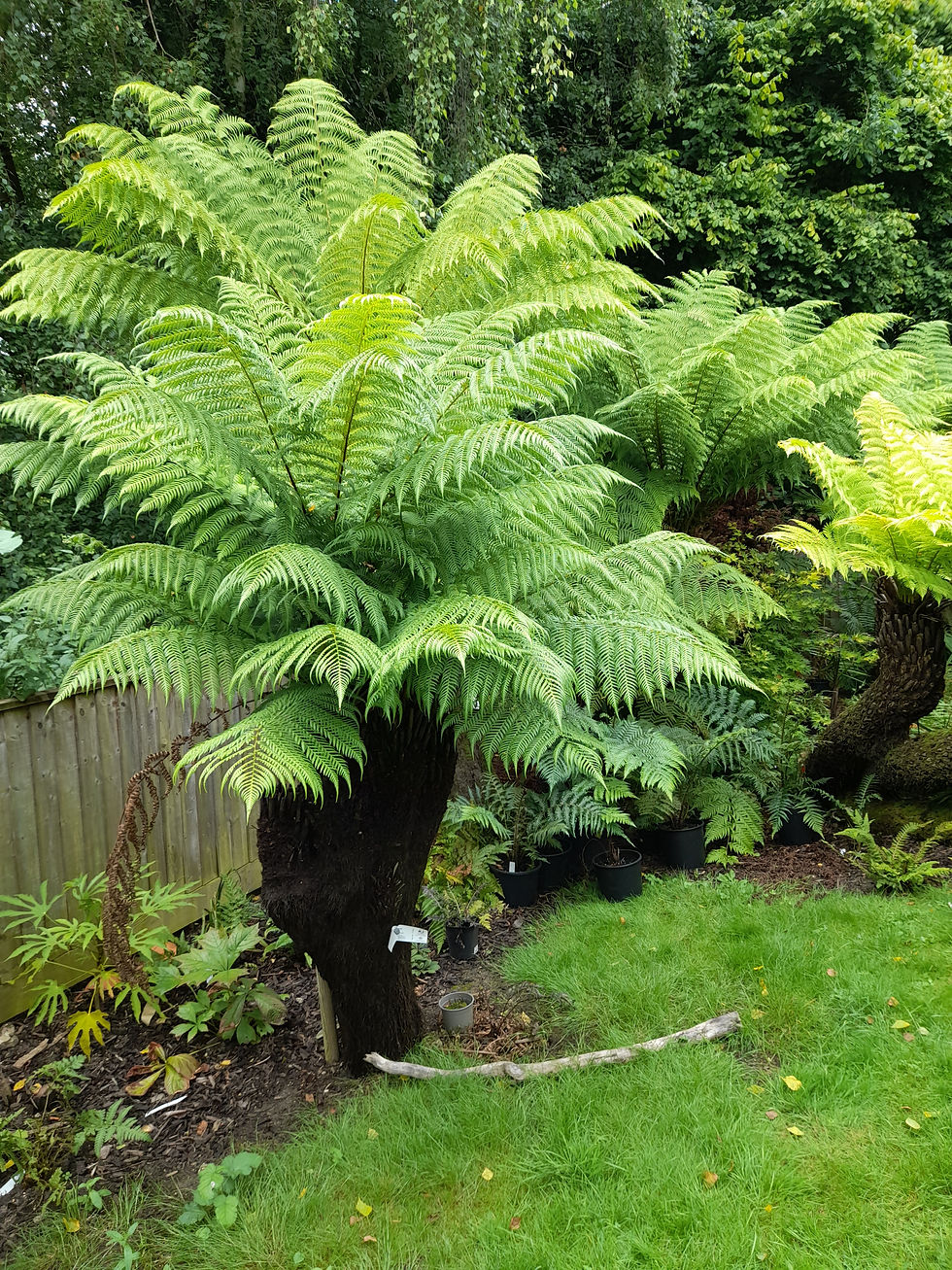What to Look for When Shopping for Tree Ferns
- lbarrett121
- Jul 17
- 4 min read
Shopping for tree ferns can be an enriching experience. These unique plants can elevate any garden space with their lush foliage and distinct appearance. However, knowing what to look for can make all the difference between a thriving tree fern and a struggling one. In this blog post, we will explore essential tips and factors to consider when shopping for tree ferns.
Factors to Consider When Shopping for Tree Ferns
When embarking on your tree fern shopping journey, consider several key factors:
Species Variability: Tree ferns belong to various species, with the most popular being the Dicksonia antarctica. Understanding the differences can help you choose the right one for your climate and garden style. For instance, some species thrive better in cooler temperatures, while others are more adaptable to warmer areas.
Plant Size and Maturity: Mature tree ferns can be significantly more expensive than younger ones. However, what you are buying is time, with a trunk growth rate of 1-2" per annum in the UK, it is one plant that is worth buying at the size you want (or at least the biggest you can afford) rather than buying small and waiting for it to grow. Juvenile plants are good fun to watch grow but can be trickier to keep alive in colder areas as need more protection during winter but can also easily dry out if over protected,
Quality of the Plant: A good quality tree fern should have large vibrant green fronds and a solid trunk. Check the base of the trunk for any signs of rot. Most ferns are purchased as imported logs without fronds, check inside the opening for signs of new croziers (sometimes referred to as "knuckles") inside the trunk.
Growing Conditions: Understanding your local climate and the specific growing requirements of tree ferns is crucial. These plants typically prefer shaded areas with high humidity. If you live in a drier area, extra measures, such regular watering and misting, may be necessary.
Source Ethics: Choose to buy from reputable sellers who prioritize sustainability. Avoid purchasing from sources that do not follow ecological practices, as this can lead to environmental damage and loss of biodiversity. All trunking ferns sold should have a harvesting tag with a refence number that proves it was legitimately harvested in an approved scheme (where the land is being cleared for agriculture or development anyway). Spore gown plants without trunks, do not require a tag as most are grown in the UK or in the EU.

Where is the Best Place to Plant a Tree Fern?
The location of your tree fern can greatly affect its growth and longevity. Here are some recommendations for optimal placement:
Shade: Tree ferns naturally thrive in shaded environments. Select a spot that offers protection from direct sunlight, especially during the hottest parts of the day. If you plant in full sun, and you can, just be prepared to provide additional water.
Moisture: Tree ferns prefer moist soil, so choose a location where the ground retains moisture. This could be near a pond, water feature, or in a naturally damp area of your garden.
Wind Protection: Tree ferns can be delicate. Plant them in a location sheltered from strong winds. This could be near a wall, fence, or other plants that can offer some protection.
Space for Growth: Consider the mature size of the tree fern when selecting a planting spot. Ensure there is enough space for the trunk and fronds to extend without obstruction.

Maintenance Needs of Tree Ferns
Once you have selected the perfect tree fern, maintenance is key to keeping it healthy:
Watering: Regular watering is essential, especially during dry spells. Tree ferns thrive when the soil is consistently moist but not waterlogged. Using mulch around the base can help retain moisture.
Temperature Regulation: If you live in an area with temperature fluctuations, consider covering your tree fern during extreme cold to protect it. In hotter climates, ensure adequate shading.
Fertilization: Feed your tree fern with a balanced fertilizer during the growing season.
Pruning: Remove only dead or damaged fronds after winter. This is best done in early spring before the new growth begins and be sure to cut 6-8" above the base of the frond as the roots grow around the old stipe bases, do not try to replicate the original harvesting cut as this will harm the plant.
Where to Buy Tree Ferns
When it comes to purchasing tree ferns, do your research. You can find tree ferns at local nurseries, garden centres, or online stores. Ensure you’re buying from a reputable source. For a reliable option, check out this link for where to buy tree ferns. We offer a variety of interesting and unique tree ferns as well as a sourcing service to find your perfect fern.
Final Tips for Shopping for Tree Ferns
Assess Your Climate: Always ensure the tree fern is suitable for your climate zone. Consult a local gardening guide if unsure.
Ask Questions: Don't hesitate to ask sellers about their tree ferns' care. Knowledgeable staff can provide invaluable insights, however, if the seller doesn't seem to know what they are talking about - buy elsewhere!
Join a Community: Consider joining a gardening community or forum like "UK Tree Fern Growers" Facebook group. These platforms are great for sharing experiences, tips, and recommendations.
Remember, a tree fern can become a stunning focal point in your garden with the right care and placement. By taking the time to research, you will ensure a positive shopping experience and a thriving addition to your green space. Happy gardening!




Comments